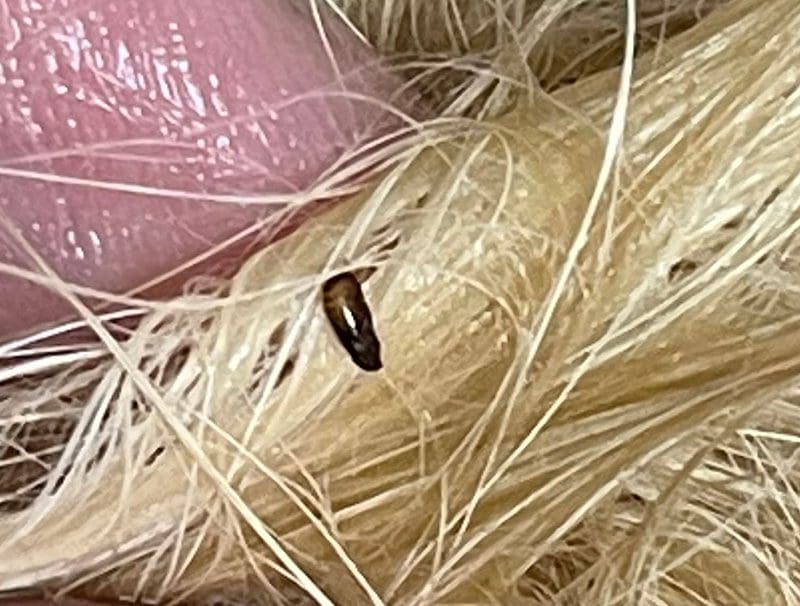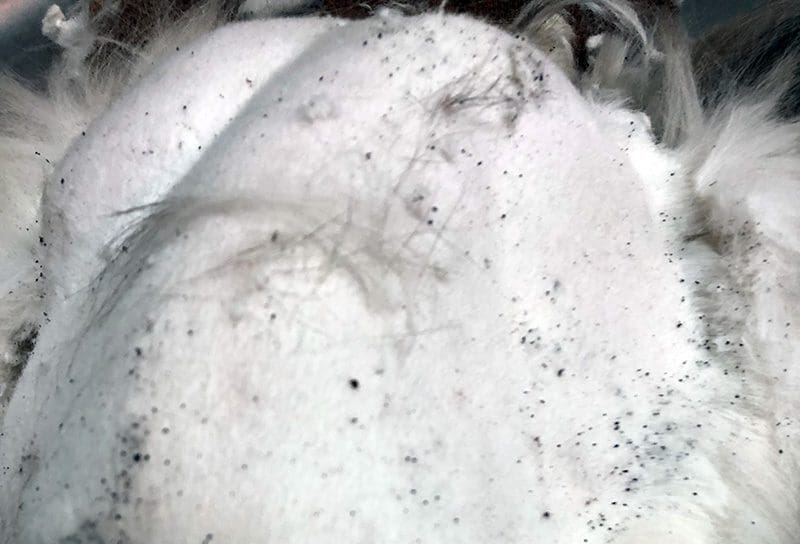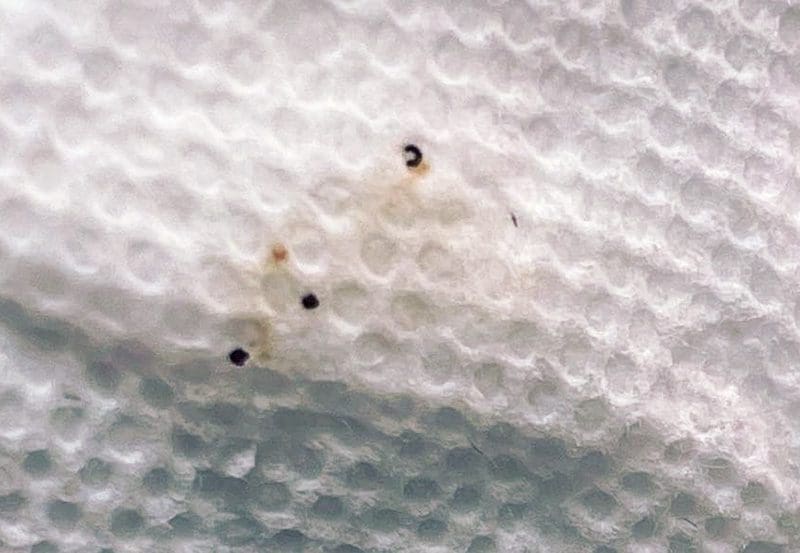
How to Tell if a Cat has Fleas
If you want to learn how to tell if a cat has fleas, you have come to the right place.
As a professional cat groomer and cat enthusiast, I have just about seen it all.
In this article I will teach you how to know if your cat has fleas and I’ll also show you effective ways to get rid of your cat’s fleas.
Let’s stop scratching and start learning!
In this Article We Cover:
- How Do I Know if My Cat has Fleas? (Products and Tips)
- If My Cat DOES Have Fleas, What Should I Do?
- How Do I Get the Cat Fleas Out of My House?
- Common Mistakes People Make When Treating a Cat for Fleas
- What About Seresto Flea Collars for Cats?
How Do I Know if My Cat has Fleas? (Products and Tips)

It’s always flea season and that means your cat can get fleas at any time of year.
As the temps cool down in late summer, or warm up in late winter, fleas will be on a mission to infest your cat’s skin and coat.
Many people treat their cat for fleas year-round. This is a good idea if you have a property or lifestyle that keeps fleas and ticks close by.
For some cats, it may not be obvious that they have a flea issue until it becomes a major infestation. This is particularly true for cats with thick coats.
So how do you tell if your cat has fleas before it becomes a major problem?
Read on and I will teach you exactly how to find out.
Amazon Affiliate Program
My clients will often ask me what products I buy for my own pets. I signed up for the Amazon Associate Program so that I can include Amazon product links in this article.
If you click on a link below and make a purchase, I will receive a small commission at no extra cost to you. I truly appreciate this as it helps me to continue my mission to provide pet wellness education. Thank you so much!
The Flea Detecting Power of a Flea Comb
You may not know right away if your cat has fleas.
I often find them during baths, but the cat was only scratching occasionally according to his people.
To tell if your cat has fleas, it is helpful to have a flea comb such as the CONAIRPRO Flea Comb for Cats
Once you have a flea comb, do the following:
1.) Get a paper towel and wet it.
2.) Use the flea comb at the base of your cat’s tail and try to get the comb to the base of the hairs.
3.) Gently tap the flea comb on the wet paper towel and observe your findings.
You probably will not catch any fleas unless you’re dealing with a lot of fleas, but you may find small peppery black flecks on your cat.

These black flecks on your cat’s skin are not fleas. The black flecks are actually dried blood which is excreted by the fleas.
When you put these black flecks on the wet paper towel, they will rehydrate and turn into red blots.
If you see red blots on the wet paper towel, you know your cat has fleas!

If you don’t see any red blots, but your cat still seems to be itchy, your cat may have a skin condition that is unrelated to fleas.
These skin conditions should be examined by a vet.
If My Cat DOES Have Fleas, What Should I Do?
Okay, so you’ve seen the red blots, and you know that your cat has fleas. Now what?
Let’s Get to the Vet!
The most effective, easy to use, and fastest-acting products are prescription strength and can only be prescribed by a vet.
If your cat is on a regular, yearly schedule for examinations, your vet can prescribe you medications to treat your cat for fleas.
If your cat hasn’t been seen in a while, schedule an appointment with a vet as soon as you can.
It is illegal for your vet to prescribe medications unless they have examined your cat, so your vet will need to give your cat a checkup first.
Is it Worth Getting a Prescription Flea Treatment?
Absolutely! Fleas have various tricks to hide while under attack. Once the danger has passed, they will just re-infest your cat.
The prescription strength flea treatments are designed to handle this.
Over the counter and home remedies are not.
You should treat your cat for at least 3 consecutive months to disrupt the flea life cycle.
I’ve used prescription strength topicals which are applied to the back of the neck, and pills that often come in a chewable tablet or treat, but your vet will discuss the best options for your cat.
Your vet may also prescribe a dewormer, since your cat can get a tapeworm from swallowing fleas while he chews and scratches.
Tapeworms will affect your cat’s health negatively, so you’ll want to make sure you follow your vet’s advice on treatment.
If One of Your Pets has Fleas, They All Do.
In a multi-pet household, a flea infestation can spread very quickly.
So, if you find that your cat has fleas, it is very likely that your other pets do as well.
If the fleas have been around long enough for your cat to have flea dirt in his coat, you should plan for 3 months of uninterrupted flea treatments for all of the warm-blooded animals in your home.
How Do I Get the Cat Fleas Out of My House?
Vacuum your home daily with a quality vacuum like Kenmore Intuition Bagged Upright Vacuum to pull the eggs, larvae, pupa, and fleas out of the crevices, corners, cracks, carpet, and furniture where they tend to hide.
Keep vacuuming carpets, bare floors, furniture, and crevices of your home frequently and thoroughly.
This can be tapered off as the flea treatments take effect.
Any remaining fleas will be attracted to your now-immune cat where they will be dispatched by the safe and quality-tested flea treatment.
Fleas Don’t Live on Humans, But They Do Bite Us!
Fleas don’t live on humans, since our body temperature is too low. However, fleas can and do bite us.
Fleas lay eggs that are designed to fall off your cat and hide in the carpet and crevices in your furniture.
The flea dirt, or dried blood that the adult fleas excrete from feeding on your cat, also falls off your cat. The flea dirt feeds the larvae that hatch from the eggs.
Larvae then pupate into nymphs. These are what you might see jumping around on the floor. The nymphs are often the culprits who bite us.
Once the nymph fleas become adults, they will seek out hosts to continue the life cycle.
Vacuuming removes the new generation of fleas and their food source, and the three months of treatment disrupts the cycle so new fleas cannot hatch.
Common Mistakes People Make When Treating a Cat for Fleas
There are a variety of home remedies, over the counter products, and outdated treatments that have all been found to be ineffective in the long term. Some of these techniques can even harm your cat.
A prescription flea treatment from your vet is the best solution we currently have for flea elimination and prevention. Your cat is worth it!
Flea Baths Do Not Work
Flea baths and dips are ineffective and way more complicated than a prescription flea treatment from your vet.
I do not offer flea baths, dips, or treatments at the grooming shop.
Fleas are well adapted to surviving flea baths.
Fleas will actually crawl into body orifices until the bath is over, and then re-emerge.
Once the fleas re-emerge, they get right back to work and re-infest your cat.
The flea treatment products prescribed by your vet will be the most up-to-speed on killing not just the adults, but the larva and eggs.
Dawn Dish Soap Doesn’t Recommend Their Product Be Used as Cat Shampoo
Dawn dish soap is often used by well-meaning individuals and it does suffocate many of the adult fleas on your cat.
However, this doesn’t address the flea eggs and larvae, so your cat will just become re-infested.
I wrote to the makers of Dawn Dish Soap (P&G) to ask them directly about this.
Here is the response I received:
We don’t recommend using Dawn on pets because we haven’t tested it.
Although we’re proud of Dawn’s role over the last 25 years, cleaning up wildlife affected by oil spills, the cleanup is complicated and performed by professionals in bird and wildlife organizations.
They understand the delicate balance required to remove the contamination while increasing their chances for survival.
We recommend that pet owners ask their vet for advice on washing their pet to not upset their natural chemistry.
Alicia
Dawn Team
P&G Consumer Relations
Many of the flea treatment products from your vet work by spreading through the natural oils in your cat’s coat.
Dawn will strip the oils out of your cat’s coat and make the flea treatment product less effective.
If your cat is extremely itchy and you want to give them immediate relief, a thick cat shampoo will kill fleas in the same way that dawn would – by suffocating them.
That is why the myth tells you to leave Dawn on your pet for 15 minutes.
A quality cat shampoo won’t dry your cat’s skin and hair like a dish detergent. Additionally, cat shampoo has been thoroughly tested for use on cats.
Over the Counter Flea Treatments Are Ineffective
I would never use Hartz brand or any other over-the-counter brand at a local store.
These products are ineffective at best and dangerous at worst.
The products available at your vet have stringent safety and effectiveness standards that they are tested for.
The store products do not have these standards, which is why they are cheaper.
Essential Oils Can Harm Your Cat
Essential oils are unlikely to help unless used in quantities and concentrations that can cause harm (such as chemical burns) to your cat.
Tea Tree Oil, Eucalyptus, and Lavender can be especially harmful to cats.
Eucalyptus oil and cedar oil are actually toxic by design and the smell is a warning to animals to stay away.
Along with causing skin irritation and burns, cedar oil can cause lung and liver damage.
Flea collars, including those that contain essential oils, can be problematic because of the types of chemicals and oils that they use.
They can also create an entrapment risk, particularly for small cats who venture outside.
What About Seresto Flea Collars for Cats?
Recent articles concerning Seresto collars should be taken with a grain of salt.
Your vet should always be your first source of information regarding the quality and safety of the products that they provide.
Never buy your flea products from anyone other than your vet to avoid counterfeit and less-stringently regulated and tested products.
Always go back to your vet and inform them if your cat is having a bad reaction to a medication or treatment.
Inform your vet immediately if the treatment you bought has not killed all the fleas on your cat in the amount of time stated on the packaging.
Your vet may prescribe a different treatment, and some manufacturers will back their product with money back guarantees.
Conclusion
Now you know how to tell if your cat has fleas and what to do about it if he does!
Fleas can be very uncomfortable for your cat and even dangerous to his health.
If you have multiple pets in your home, a flea infestation can spread quickly and negatively impact all of your pets.
If you find that your cat has fleas, work closely with your vet to solve the problem quickly and effectively.
I hope you found this article to be helpful and I wish you and your cat many wonderful and flea free years together!
Ready for More Cat Articles?
Please check out our Cat Blog for a full listing of all of our cat articles!
Join Our Mailing List!
We hope you enjoyed reading this article! The Absolute Animal Care Blog features articles that contain our best recommendations for dog and cat wellness, training strategies, and products.
Please join our mailing list to receive updates when new articles are released!
First Cat Photo by Andrew Umansky
All Other Photos by Absolute Animal Care
